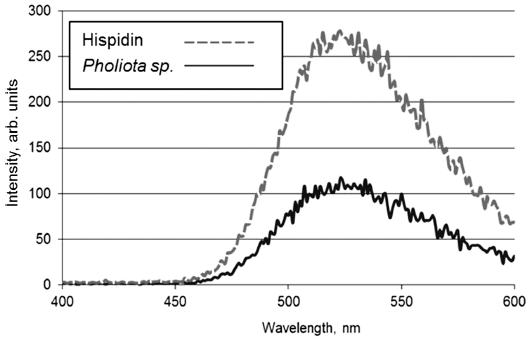Search
- Page Path
- HOME > Search
- [English]
- Interaction of Detonation Nanodiamonds with Hispidin
- Changkyu Rhee, Whungwhoe Kim, Andrey E. Burov, Alexey P. Puzyr, Vladimir S. Bondar
- J Korean Powder Metall Inst. 2020;27(6):458-463. Published online December 1, 2020
- DOI: https://doi.org/10.4150/KPMI.2020.27.6.458

- 517 View
- 1 Download
-
 Abstract
Abstract
 PDF
PDF Hispidin is a secondary metabolite found in numerous medicinal mushrooms that has attracted significant attention, owing to its distinct biological effects, including antioxidant, anti-inflammatory, antitumor, and cytoprotective properties. Experiments are being carried out to study the interaction of detonation nanodiamonds (DNDs) with synthetic and natural hispidin sourced from extracts of
Pholiota sp. fungus. The bioluminescence method is used to determine the adsorption/ desorption properties of DNDs toward hispidin. It is found that hispidin forms strong conjugates with DNDs, and the use of various eluents does not result in a significant release of the adsorbed hispidin molecules. DND-bovine serum albumin (BSA) complex, where DNDs serve as a carrier for the protein and the latter acts as a hispidin sorbent, has been developed and applied in hispidin adsorption/desorption tests. The results support the use of the DNDs as a carrier for hispidin in medical applications. They also advocate the application of the DND-BSA complex for isolating the substance from fungal extracts.
- [English]
- Nanodiamonds Conjugated with Nonsteroidal Anti-inflammatory Drugs for Transdermal Delivery
- Changkyu Rhee, Alexey P. Puzyr, Andrey E. Burov, Olga G. Burova, Whungwhoe Kim, Vladimir S. Bondar
- J Korean Powder Metall Inst. 2018;25(6):459-465. Published online December 1, 2018
- DOI: https://doi.org/10.4150/KPMI.2018.25.6.459

- 558 View
- 1 Download
- 1 Citations
-
 Abstract
Abstract
 PDF
PDF Most commercially available detonation nanodiamonds (DNDs) require further processing to qualify for use in biomedical applications, as they often contain many impurities and exhibit poor dispersibility in aqueous media. In this work, DNDs are modified to improve purity and impart a high colloidal stability to the particles. The dispersive and adsorption properties of modified DNDs are evaluated in terms of the suitability of DNDs as carriers for non-steroidal anti-inflammatory drugs (NSAIDs) in transdermal delivery. The study of adsorption on strongly positively and strongly negatively charged DNDs showed their high loading capacity for NSAIDs, and a pronounced relationship between the drugs and the particles’ charges. Experiments on long-term desorption carried out with DND/NSAID complexes indicate that the nanoparticles exert a sustained effect on the drug release process.
-
Citations
Citations to this article as recorded by- Unveiling the trending paradigms of synthesis and theranostic biomedical potentials of nano-diamonds (NDs) - a state-of-the-art update
Sagnik Nag, Kedlaya Srikrishna H. Damodar, Swayambhik Mukherjee, Dinesh R. Rao, Ipsita Debnath, Sree Haryini, Sourav Mohanto, Mohammed Gulzar Ahmed, Vetriselvan Subramaniyan
Inorganic Chemistry Communications.2025; 177: 114313. CrossRef
- Unveiling the trending paradigms of synthesis and theranostic biomedical potentials of nano-diamonds (NDs) - a state-of-the-art update
- [Korean]
- Deaggregation and Ultradispersion of Detonation Nanodiamonds in Polar Solvent Using Physicochemical Treatments
- Changkyu Kim, Gyoung-Ja Lee, Changkyu Rhee
- J Korean Powder Metall Inst. 2013;20(6):479-486.
- DOI: https://doi.org/10.4150/KPMI.2013.20.6.479

- 589 View
- 1 Download
- 3 Citations
-
 Abstract
Abstract
 PDF
PDF - In the present work, physicochemical treatments were introduced for de-aggregation and stable dispersion of detonation nanodiamonds (DND) in polar solvents. The DNDs in water exhibited a particle size of 138 nm and high dispersion stability without particular treatment. However, the DNDs in ethanol were severely aggregated to several micrometers in size and showed poor dispersion stability with time. To break down aggregates of DNDs and enhance the dispersion stability of them in ethanol, mechanical force and chemical surfactant were introduced as functions of zirconia ball size, kind of surfactant and amount of surfactant added. From the analyses of average particle size and Turbiscan results, it was suggested that the size of DNDs in ethanol can be reduced by only mechanical force; however, the DNDs were re-aggregated due to high surface activity. The long-term dispersion stability can be achieved by applying mechanical force to break down the aggregates of DNDs and by preventing re-aggregation of them using proper surfactant.
-
Citations
Citations to this article as recorded by- Material Removal Model for Lapping Process Based on Spiral Groove Density
Taekyung Lee, Haedo Jeong, Sangjik Lee, Hanchul Cho, Doyeon Kim, Hyoungjae Kim
Applied Sciences.2021; 11(9): 3950. CrossRef - Fundamental aspects and recent developments in electropolishing
Wei Han, Fengzhou Fang
International Journal of Machine Tools and Manufacture.2019; 139: 1. CrossRef - Effect of added ethanol in ethylene glycol–NaCl electrolyte on titanium electropolishing
Donghyun Kim, Kyungsik Son, Dahye Sung, Yonghwan Kim, Wonsub Chung
Corrosion Science.2015; 98: 494. CrossRef
- Material Removal Model for Lapping Process Based on Spiral Groove Density
TOP
 KPMI
KPMI


 First
First Prev
Prev


